

Aktzin. Aktzin (alternate spellings: Aktsin, Aktsini, Aktziní) was the god of rain, thunder and lightning for the Totonac people in ancient Mexico.
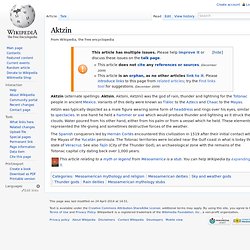
Variants of this deity were known as Tláloc to the Aztecs and Chaac to the Mayas. Aktzin was typically depicted as a male figure wearing some form of headdress and rings over his eyes, similar to spectacles. In one hand he held a hammer or axe which would produce thunder and lightning as it struck the clouds. Water poured from his other hand, either from his palm or from a vessel which he held.
These elements represented the life-giving and sometimes destructive forces of the weather. The Spanish conquerors led by Hernán Cortés encountered this civilization in 1519 after their initial contact with the Mayas of the Yucatán peninsula. Chaac. Earthenware effigy urn (an incense burner) of Chaac, 12th-14th century Chaac (also spelled Chac or, in Classic Mayan, Chaahk [t͡ʃaːhk]) is the name of the Maya rain deity.
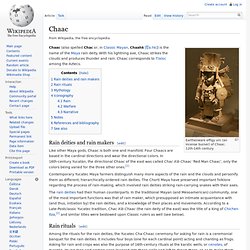
With his lightning axe, Chaac strikes the clouds and produces thunder and rain. Chaac corresponds to Tlaloc among the Aztecs. Rain deities and rain makers[edit] Like other Maya gods, Chaac is both one and manifold. Contemporary Yucatec Maya farmers distinguish many more aspects of the rain and the clouds and personify them as different, hierarchically-ordered rain deities. The rain deities had their human counterparts. Rain rituals[edit] Cocijo. Cocijo[pronunciation?]
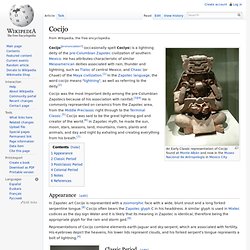
(occasionally spelt Cociyo) is a lightning deity of the pre-Columbian Zapotec civilization of southern Mexico. Heyoka. A Heyoka (in Lakota, Heyókȟa, also spelled "Haokah," "Heyokha") is a trickster spirit, a contrarian, jester, satirist or sacred clown.

The Heyoka spirit speaks, moves and reacts in an opposite fashion to the people around it. Social role[edit] Heyókȟa are thought of as being backwards-forwards, upside-down, or contrary in nature. This spirit is often manifest by doing things backwards or unconventionally — riding a horse backwards, wearing clothes inside-out, or speaking in a backwards language.
For example, if food were scarce, a Heyókȟa would sit around and complain about how full he was; during a baking hot heat wave a Heyókȟa would shiver with cold and put on gloves and cover himself with a thick blanket. He was always running around with a hammer trying to flatten round and curvy things (soup bowls, eggs, wagon wheels, etc.), thus making them straight. Inca mythology. Inca mythology includes many stories and legends that are mythological and to explain or symbolizes Inca beliefs.[1] All those that followed the Spanish conquest of the Inca Empire by Francisco Pizarro burned the records of the Inca culture.
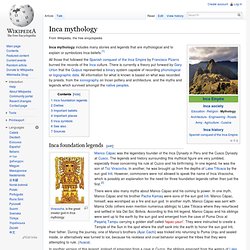
There is currently a theory put forward by Gary Urton that the Quipus represented a binary system capable of recording phonological or logographic data. Thunderbird (mythology) The thunderbird is a legendary creature in certain North American indigenous peoples' history and culture.
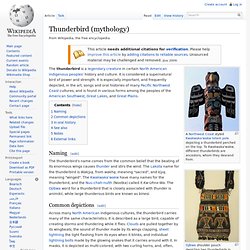
It is considered a supernatural bird of power and strength. It is especially important, and frequently depicted, in the art, songs and oral histories of many Pacific Northwest Coast cultures, and is found in various forms among the peoples of the American Southwest, Great Lakes, and Great Plains. The thunderbird's name comes from the common belief that the beating of its enormous wings causes thunder and stirs the wind. The Lakota name for the thunderbird is Wakį́yą, from wakhą, meaning "sacred", and kįyą, meaning "winged".
The Kwakwaka'wakw have many names for the thunderbird, and the Nuu-chah-nulth (Nootka) called it Kw-Uhnx-Wa. Tlaloc. Tlaloc (Classical Nahuatl: Tlālōc [ˈtɬaːloːk]) [1] was an important deity in Aztec religion; a god of rain, fertility, and water.
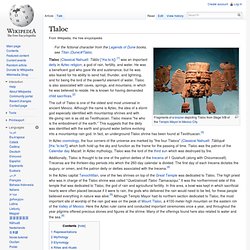
He was a beneficent god who gave life and sustenance, but he was also feared for his ability to send hail, thunder, and lightning, and for being the lord of the powerful element of water. Tlaloc is also associated with caves, springs, and mountains, in which he was believed to reside. He is known for having demanded child sacrifices.[2] The cult of Tlaloc is one of the oldest and most universal in ancient Mexico. Although the name is Aztec, the idea of a storm god especially identified with mountaintop shrines and with life-giving rain is as old as Teotihuacan. In Aztec cosmology, the four corners of the universe are marked by "the four Tlalocs" (Classical Nahuatl: Tlālōquê [tɬaːˈloːkeʔ]) which both hold up the sky and function as the frame for the passing of time.
Representations[edit] Mythology[edit] Etymology[edit] Rites and rituals[edit] Related gods[edit] Tupã (mythology) Xolotl. In Aztec mythology, Xolotl ([ˈʃolot͡ɬ]) was the god with associations to both lightning and death.

Myths and function[edit] Xolotl Although often depicted in relation to the underworld, Xolotl was not a psychopomp in the Western sense. [further explanation needed] Xolotl did, however, aid the dead on their journey to Mictlan, the afterlife in some myths.